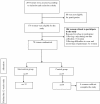Effect of physical activity intervention based on a pedometer on physical activity level and anthropometric measures after childbirth: a randomized controlled trial
- PMID: 22176722
- PMCID: PMC3292461
- DOI: 10.1186/1471-2393-11-103
Effect of physical activity intervention based on a pedometer on physical activity level and anthropometric measures after childbirth: a randomized controlled trial
Abstract
Background: Pregnancy and childbirth are associated with weight gain in women, and retention of weight gained during pregnancy can lead to obesity in later life. Diet and physical activity are factors that can influence the loss of retained pregnancy weight after birth. Exercise guidelines exist for pregnancy, but recommendations for exercise after childbirth are virtually nonexistent. The aim of this study was to evaluate the effect of physical activity intervention based on pedometer on physical activity level and anthropometric measures of women after childbirth.
Methods: We conducted a randomized controlled trial in which 66 women who had given birth 6 weeks to 6 months prior were randomly assigned to receive either a 12 week tailored program encouraging increased walking using a pedometer (intervention group, n = 32) or routine postpartum care (control group, n = 34). During the 12-week study period, each woman in the intervention group wore a pedometer and recorded her daily step count. The women were advised to increase their steps by 500 per week until they achieved the first target of 5000 steps per day and then continued to increase it to minimum of 10,000 steps per day by the end of 12th week. Assessed outcomes included anthropometric measures, physical activity level, and energy expenditure per week. Data were analyzed using the paired t-test, independent t-test, Mann-Whitney, chi-square, Wilcoxon, covariance analysis, and the general linear model repeated measures procedure as appropriate.
Results: After 12 weeks, women in the intervention group had significantly increased their physical activity and energy expenditure per week (4394 vs. 1651 calorie, p < 0.001). Significant differences between-group in weight (P = 0.001), Body Mass Index (P = 0.001), waist circumference (P = 0.001), hip circumference (P = 0.032) and waist-hip ratio (P = 0.02) were presented after the intervention. The intervention group significantly increased their mean daily step count over the study period (from 3249 before, to 9960 after the intervention, p < 0.001).
Conclusion: A physical activity intervention based on pedometer is an effective means to increase physical activity; reducing retention of weight gained during pregnancy and can improve anthropometric measures in postpartum women.
Trial registration: ISRCTN: IRCT201105026362N1.
Figures
References
-
- Arthur C, Guyton John E. Textbook of Medical Physiology. 11. Philadelphia: Saunders; 2005. p. 103.
-
- Cunningham FG, Norman FG, Leveno KJ, Gilstrap LC, Hauth JC, Wenstrom KD. Williams Obstetrics. 23. USA: McGraw-Hill Professional; 2010. p. 200.
-
- Maddah M. Pregnancy weight gaining Iranian women attending a cross-sectional study of Public Health Centers in Rasht. Midwifery. 2005;21(4):365–370. - PubMed
-
- Harris V. Physical activity and weight retention in postpartum Black women. Journal of the National Society of Allied Health. 2009;6(7)
-
- Linne Y, Barkeling B, Rossner S. Long-term weight development after pregnancy. Obes Rev. 2002;3(2):75–83. - PubMed



